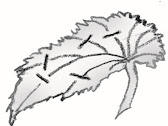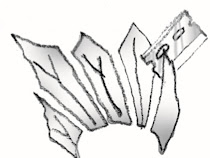Cutting is a portion of a stem, root, or leaf cut from the parent plant for the production of a new independent plant by inducing it to form shoots and roots under favorable environmental conditions (for example, stem cuttings, leaf-bud cuttings, leaf cuttings, and root cuttings).
A plant cutting is a piece of a plant that is used in horticulture for vegetative or asexual propagation. A piece of the stem, root, or leaf of the source plant is placed in a suitable medium such as moist soil. If the conditions are suitable, the plant piece will begin to grow as a new plant independent of the parent plant, a process known as striking. A few plants can be developed from leaf pieces, called leaf cuttings, which produce both stems and roots. The scions utilized in grafting are likewise called cuttings.
Types of cutting
There are three types of cuttings:
(1) Leaf cutting
(2) Stem cutting
(3) Root cutting
(1) Leaf cutting
Leaf cuttings are used almost for a few indoor plants. Leaves of most plants will either create a few roots however no plant or simply decay.
Whole leaf with petiole
Separate the leaf and up to 1 inches of petiole. Place the lower end of the petiole into the medium. One or more new plants will be formed on the basis of the petiole. When they have their own roots, the leaves can be cut from new plants, and the petals can be reused. For example African violet.
Whole leaf without petiolate
This is utilized for plants with sessile leaves (no stalk or petiole). Insert the cutting vertically into the medium. A new plant will produce from the axillary bud. The leaves can be cut off when the new plant has its own roots. For example donkey’s tail.
Split vein
Detach a leaf from the stock plant. Cut its veins on the lower leaf surface. Lay the cutting, drop side down, on the medium. New plants will form at each cut. If the leaf has a tendency to curl, keep it in place by covering the margins with the rooting medium. For example Rex begonia.
Leaf sections
This technique is frequently used with snake plant and fibrous-rooted begonias. Cut begonia leaves into wedges with at any rate one vein. Lay leaves flat on the medium. Another plant will arise at the vein. Cut snake plant leaves into 2-inch sections. Reliably, make the lower cut inclined and the uppercut straight so you can tell which is the top. Insert the cutting vertically. Roots will form fairly soon, and eventually, another plant will show up at the base of the cutting. These and other succulent cuttings will decay if kept too moist.
(2) Stem cuttings
Propagation by stem cuttings is the most commonly used method to propagate numerous woody ornamental plants. Stem cuttings of many favorite shrubs are very easy to root. Generally, stem cuttings of tree species are more difficult to root. However, cuttings from trees such as crape myrtles, elms, and birches, etc can be rooted.
Tip cuttings
Separate a 2- to 6-inch piece of stem, including the terminal bud. Make the cut below a node. Remove lower leaves that would touch or below the medium. If it is desired, dip the stem in rooting hormone. Gently tap at the end of the cutting to remove excess hormone. Then make a hole in the medium with a pencil or pot label, and insert the cutting deeply enough into the media to support itself.
Medial cuttings
Make the first cut above a node, and the second cut just below a node 2 to 6-inches down the stem. Prepare and insert the cutting as you would tip cutting. Make sure the position on the right side up. The buds are always above the leaves. Be sure the cutting is inserted base down.
Cane cuttings
Cut cane-like stems into segments containing one or a couple of eyes, or nodes. Dust is removed by fungicide or activated charcoal. Allow to dry for several hours. Lay horizontally with about
half of the cutting beneath the media surface, eye facing
upward. Wheat cuttings are usually planted when roots and new shoots appear, but new shoots of Dracaena and Croton are often cut and spread in the sand.
Single eye
The eye refers to the bud that rises on the axil of the leaf at every node. It is used for alternative leafy plants when alternative space or stock material is limited. Cut about 1/2 inch above the stem and 1/2 inch below the node. Place the cutting horizontally or vertically within the medium with the node which simply contracting the surface.
Double eye
It is used for plants with opposite leaves when space or reserve material is limited. Cut the stem approximately _ inch above and _ inch below the similar nod. Insert the cut vertically in the medium with the node simply touching the surface.
Heel cutting
This technique uses stock material with woody stems efficiency. Make a shield cut about halfway through the wood around a leaf and an axial bud. Insert the shield horizontally in the middle so that it is totally covered. Remove any leaf blades, but keep a part of the petiole intact to facilitate handling of this small cut.
(3) Root cutting
Root cuttings are generally taken from 2-3-year-old plants during their dormant season when they have a large supply of carbohydrates. The root cuttings of certain species produce new shoots, which then form their own root systems, while the root cuttings of other plants form root systems before developing new shoots.
Plants with large roots
Cut straight up. Create a slanted cut 2 to 6 inches below the main cut. Store around 3 weeks in wet sawdust, peat moss, or sand at 40˚F. Take out from storage. Place the cutting vertically with the top approximately level with the surface of the rooting medium. This method is often used for outdoor plants for example horseradish.
Plants with small roots
Take 1-2 inch parts of roots. Place the cuttings horizontally about1/2 inch beneath the medium surface. This method is usually used in indoor plants or in a hotbed, for example, bleeding heart.









Post a Comment
Please do not enter any spam link in the comment box. Thanks for your interesting in my website.